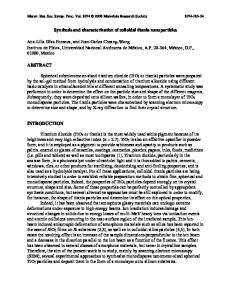Thermal Effects of Colloidal Suspensions of Au Nanoparticles
- PDF / 3,397,190 Bytes
- 6 Pages / 612 x 792 pts (letter) Page_size
- 83 Downloads / 311 Views
1172-T05-08
Thermal Effects of Colloidal Suspensions of Au Nanoparticles Michael T. Carlson1, Tyler S. Barton1, Pete J. Tandler2, Hugh H. Richardson1 and Alexander O. Govorov3 1 Department of Chemistry and Biochemistry, Ohio University, Athens, Ohio 45701. 2 Department of Math and Sciences, Walsh University, North Canton, Ohio 44720 3 Department of Physics and Astronomy, Ohio University, Athens, Ohio 45701. ABSTRACT The thermo-optical properties of gold nanoparticles suspended in liquid water droplets have been explored. A water droplet containing suspended gold nanoparticles was irradiated with a laser beam and the efficiency of light-to-heat conversion (η) was determined. Heat generated by the optically stimulated nanoparticles was found to dissipate through several mechanisms. Convection currents were observed visually inside the droplet by the addition of silica beads (~3-10 micrometers). This was determined to be the dominant mechanism of stirring within the droplet. INTRODUCTION Understanding the thermal properties of optically stimulated nanoparticles has become of great interest as of late1-5. The study of this new class of materials known as nanoheaters includes understanding the heat-generating behavior of nanostructures under optical illumination. In this paper, we investigate the behavior of colloidal 20nm gold nanoparticles suspensions when irradiated with a 532nm wavelength CW laser. We show that the change in temperature of a droplet of this colloidal solution when irradiated with a laser beam can be modeled with a low degree of uncertainty and that there is a near unity efficiency for converting photon energy into heat1. We also show that convection currents inside the droplet are the primary means of stirring the liquid and reducing thermal gradients within the droplet. EXPERIMENTAL An apparatus was designed and constructed that allowed both temperature and video data to be collected of a small droplet while being irradiated with a laser beam. First, a syringe (1 mL, G 3/8 intradermal bevel needle, Becton Dickinson & Co., Franklin Lakes, NJ) was attached to a stand such that the needle was pointing vertically downward. A K-type thermocouple (0.003” wires, Omega Engineering, Stamford, CT) was attached to the syringe so the weld of the thermocouple was near, but not touching the needle. The thermocouple was connected to a data logger (Xplorer GLX, PASCO, Roseville, CA) by a thermocouple-to-analog connecter (Super MCJ, Omega Engineering). This thermocouple system was employed in monitoring the temperature of the droplet. Video data was also collected by digital camera (Coolpix 885, Nikon) with an attached 10x magnification eyepiece. The video of the droplet was recorded with a DVD video recorder (D-R410, Toshiba). A small piece of graph paper was placed beside the syringe in the video for a scale reference.
The experimental gold nanoparticle (Au NPs) colloidal solution was prepared by diluting a stock suspension of Au NPs (50nm gold colloid; Fabricated by British Biocell International, purchased fro
Data Loading...











